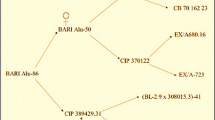Summary
Sable is an early sizing potato variety of midseason maturity. It is comparable with the variety Warba in yield of marketable tubers 80 to 90 days after planting. It has white, smooth, bright, attractive tubers with shallow eyes, and is moderately resistant to common scab. It is not recommended as a main crop variety. It is low in dry matter; however, it cooks satisfactorily as an early variety.
Resumen
La variedad Sable es de madurez intermedia pero sus tubérculos se forman temprano. Es comparable con la variedad Warba en cuanto al rendimiento de tubérculos comerciales, de 80 a 90 días después de la siembra. Sus tubérculos son atractivos, blancos, lisos, brillantes, de ojos superficiales y es moderadamente resistente a la sarna común. No se recomienda como una variedad de cultivo principal. Es baja en materia seca; sin embargo, es de rápido y buen cocimiento.
Similar content being viewed by others
Author information
Consortia
Additional information
Contribution No. 212, Research Station, Canada Department of Agriculture, Fredericton, New Brunswick, Canada. Sable, the name of an island in the Atlantic Ocean off the coast of Nova Scotia.
Potato Breeding Section.
A committee of federal and provincial workers engaged in the evaluation of the adaptability of potato seedlings in the Atlantic region.
Rights and permissions
About this article
Cite this article
Davies, H.T., Young, L.C. & The Atlantic Regional Potato Breeding Committee. Sable, a new early variety of potato. American Potato Journal 43, 154–157 (1966). https://doi.org/10.1007/BF02861642
Accepted:
Issue Date:
DOI: https://doi.org/10.1007/BF02861642




